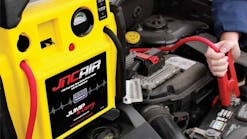The best and safest fleets today use safety award programs to recognize drivers who show a dedication to safety. While fleets use many different criteria to develop a safety award program, planning your strategy early on will help ensure that your program runs as smoothly as possible.
Here’s how you can get started today:
- Establish the outcomes you want your awards program to incentivize
- Define your safety award criteria based on events that help achieve the desired results
- Aggregate your data into one location for accurate reporting and visibility
- Define and implement your safety awards program
Step 1: Establish desired outcomes
While preventing accidents is a top priority of many fleets, safety award programs can tackle various issues your fleet faces from day to day. Before establishing your award programs, take a deeper dive into the current behavior of your drivers and try to identify where the bulk of your costs occur.
For example, preventable accidents may have been your highest cost last year, or perhaps your most significant expenses were associated with minor damages from a large number of minor accidents. Safety award programs are an excellent tool for reducing these costs.
Identifying your fleet’s problem areas and setting goals around addressing them is the very first step to establishing a successful safety award program. One thing to be aware of is that your drivers will be motivated to do whatever you choose to incentivize. Be sure you’re incentivizing the behaviors necessary to ensure fleet safety or you may have unintentional consequences or undesirable results.
Step 2: Define safety award criteria
Before your fleet can implement a safety award program, specific metrics to track awards must be defined and easily accessible. Recording and tracking safety events will help you identify drivers that are engaging in both safe and unsafe behavior. Differentiating these metrics and understanding the impact they have on your fleet is essential to laying the foundation for a successful safety award program.
Key safety events to monitor when evaluating your drivers include:
- Preventable accidents — Minor accidents such as backing accidents are common precursors to a critical incident. A series of avoidable mistakes can be part of a trend that leads to more dangerous behaviors in the future. Rewarding your safest drivers that follow best driving practices shows your team that you not only value safety, but you also value their efforts in creating a culture of safety within your organization.
- Injuries — Fleet managers have a significant amount of responsibility including preventing injuries ranging from strains and bruises to severe or even life-threatening trauma. Events that result in injury substantially increase your cost of claims and insurance premiums, which directly affects your fleet’s bottom line. Using these events as award criteria will let your drivers know that safe behavior needs to occur both behind the wheel as well as outside of the cab.
- Incidents/observations — HR-related incidents, workplace observations, and other unacceptable behaviors are additional metrics to track when considering who will be eligible for safety awards. Events that involve arguing with co-workers, supervisors, customers, or violating company policies should be criteria when establishing a reward program.
- Citations and violations — Inspections that bear violations and citations are not only costly and rack up CSA points, but they are a big red flag when it comes to evaluating driver performance. Needless to say, keeping track of citations and violations is an important metric to consider for your awards program.
- Telematics and camera alerts — Getting real-time, in-cab behavioral alerts is a powerful indicator of driver performance. Including these triggers, like speeding or harsh braking, can significantly enhance your visibility into driver behavior and provide positive incentives for safe driving habits. Including these alerts into a safety program can be difficult, since you need to account for noise in the data and find the right balance in their use.
Step 3: Aggregate your data
Before you embark on a new safety award program, be sure to consider how you plan on tracking your fleet’s safety events. Combining data from internal spreadsheets and each of your 3rd party systems can be tedious, but it’s critical to the success of your safety awards. You can learn more about how to integrate your data sources with simple-to-use tools, like the Idelic Safety Suite, to get better insights into your safety operations and more clarity and understanding around the unsafe behaviors of your drivers.
Step 4: Define and implement your safety awards
The number of awards that work as incentives for your company is only limited to the creativity of the safety managers. For those using the Idelic Safety Suite to track and automate your safety awards, simply click on the awards tab to see your current award recipients. You can see a demo of how fleets are automating these awards here.
Four awards programs to get you started
1. Safe driver award
The keystone to a successful safety culture is having dedicated and safety-focused drivers operating within your fleet. Awarding the "safe driver award" to any driver that works for 12 months with zero safety events is a great place to start.
Even the most cautious drivers can have minor and low-cost events over time, so establishing a level of severity that constitutes which events should count against a safety award is essential. Exempting certain safety events that don’t reach a set monetary amount of damages can make a safe driver award more obtainable if that is a concern.
2. Consecutive years of safe driving award
While it’s essential to keep your veteran drivers happy with long-term incentives, the key to long-term fleet safety is to reward safe drivers frequently, while also coaching your riskiest drivers before a major accident occurs.
The "consecutive years of safe driving award" is a great way to reward your drivers on an annual basis. These awards signify how many years in a row a driver has driven without a safety event. For example, if a driver has five consecutive years of safe driving and then gets into a preventable accident, their successive year's award eligibility will reset back to zero.
While recognizing drivers for maintaining a perfect driving record each year is important, giving an award for consecutive years of safe behavior can provide an additional incentive to help keep a long-running history of safe behavior.
3. Quarterly safety awards
If your fleet can give awards on a more frequent basis, a "quarterly safety award" may be a great addition to help regularly incentivize your drivers.
Sometimes, drivers need more regular recognition than some safety programs can provide. Incorporating more frequently obtainable awards, such as quarterly awards complemented by long-term achievements, can help keep your drivers motivated to maintain their safe behavior.
4. Million mile award
We know that high turnover rates coupled with our current driver shortage make keeping good drivers very difficult. Implementing the "million mile award" creates a measurable goal for your most seasoned drivers and will help incentivize them to stay with you for the long haul.
Contrary to what the name says, the million mile award doesn’t always have to be triggered when a driver clocks in exactly one million miles. Fleets can choose to give this award to drivers who have spent anywhere from 9-12 years with their company, using the average amount of time it takes for a driver to reach one million miles based on the types of routes they run.
The million mile award rewards driver loyalty, so make sure this award is not only achievable but also is held in high regard within your organization.
With the Idelic Safety Suite, fleets are able to closely track all aspects of driver behavior. Features such as an advanced Driver Watch List and a performance improvement plan can help steer your drivers towards the road to the million mile award for being loyal and safe drivers within your fleet.
Help Your Drivers Succeed
The best way to run a safety award program is to incentivize driver safety while also taking a proactive approach to help your at-risk drivers become award winners. Using your current fleet data (telematics, cameras, violations/citations, incidents, HR, and other safety metrics) to monitor your drivers proactively will allow you to identify poor driver behavior patterns and trends over time.
To do this effectively, integrating your data sources into one place is crucial. Whether you are compiling all of your data into a concise driver scorecard or the Idelic Safety Suite Watch List, analyzing all fleet data in one location is key to creating a safety culture where every driver can be an award winner.
Information provided by Idelic


